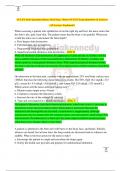Exam (elaborations)
NCLEX Style Questions Burns, Med Surg - Burns NCLEX Exam Questions & Answers (All Answers Explained!)
- Course
- Institution
NCLEX Style Questions Burns, Med Surg - Burns NCLEX Exam Questions & Answers (All Answers Explained!)-When assessing a patient who spilled hot oil on the right leg and foot, the nurse notes that the skin is dry, pale, hard skin. The patient states that the burn is not painful. What term would the n...
[Show more]



